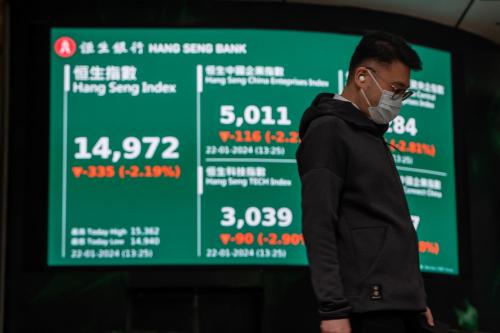In recent commentary for the Financial Times, David Pilling argues that the central objective of the Trans-Pacific Partnership trade negotiations is the exclusion of China. In his view, the desire to build an “anyone but China” club is due both to the perception that China got an easy pass when it joined the WTO and has continued to flaunt international trade and investment rules; and to the articulation of a larger political strategy to marginalize this emerging superpower. Pilling goes on to predict that the TPP will fail to deliver major liberalization as the traditional pattern of shielding sensitive sectors will emerge, and admonishes that only a much diluted trade agreement faces a realistic chance of ratification given the fractured consensus on the new proposed rules. In this rendition, the TPP appears politically myopic and economically irrelevant.
The argument that the TPP is a club that bars Chinese entry is inaccurate and unhelpful. China, like any other APEC economy, has the right to request entry into the TPP. Whether the Chinese leadership will judge TPP membership to be in their country’s national interest and whether TPP members can be persuaded that China is prepared to abide by the negotiated disciplines is a separate matter. But it is important to dispel the notion that the TPP precludes Chinese entry. In fact, this trade agreement scores better than most in incorporating an accession mechanism that has already delivered membership expansion from four to twelve members –now comprising 40% of world GDP. More fundamentally, it is hard to understand why TPP countries would pursue the counter-productive and unfeasible goal of marginalizing China. China sits at the apex of the world economy as it ranks number two in share of world GDP and is at the center of global supply chains. A trade agreement that by fiat sought to defy these fundamental economic realities would be foolhardy indeed. Hence the TPP concept is expansive: it aims to eventually develop an Asia-Pacific wide platform of economic integration, not to draw lines encircling China.
If Chinese exclusion were the selling point of the TPP for countries like Japan, then one would be hard pressed to explain why the Japanese government is concurrently negotiating two major trade agreements with China: a trilateral FTA in Northeast Asia and an East Asian trade agreement known as the Regional Comprehensive Economic Partnership (RCEP). And the same is true for all other Asian countries in the TPP who already partake in the ASEAN-China FTA and are participating in the RCEP talks. The “us versus them” dynamic of security alliances is not really applicable to free trade agreements. The noodle bowl that characterizes the maze of FTAs illustrates the fact that in the world of international trade overlapping memberships render moot purely exclusive arrangements.
Ascribing an anti-China objective to the TPP is not helpful on three main fronts: 1) it provides political cover to protectionist interests, who argue that they should not be asked to undertake painful economic adjustments for the sake of trade agreements driven by geopolitical concerns; 2) it sends a chilling message to prospective members, who may fear that in joining TPP they will be seen as enlisted in the anti-China camp; and 3) it will discourage China from finding points of convergence with the TPP agenda if this is seen as capitulating to an American strategy of containment.
The most fundamental challenge to the TPP project vis-à-vis China is not that it is built around a faulty notion of containment, but rather that it may not constitute a powerful enough enticement to propel China to sign on to these new standards on trade and investment. China so far has reacted by accelerating its own trade initiatives in Asia. The risk that the United States and China will remain for the foreseeable future in separate trade groupings, without a significant bilateral dialogue on trade and investment, is very real. TPP negotiators cannot postpone the task of fashioning a strategy to engage China until after the TPP agreement is completed. They must be mindful of the fact that rules must be evaluated both in terms of their quality and dissemination potential. China must see in the new trade agenda a deal not unlike its accession to the WTO: while hefty commitments are to be expected, the accompanying domestic reforms will pay off handsomely in terms of improved economic performance.


Commentary
The Containment Fallacy: China and the TPP
May 24, 2013